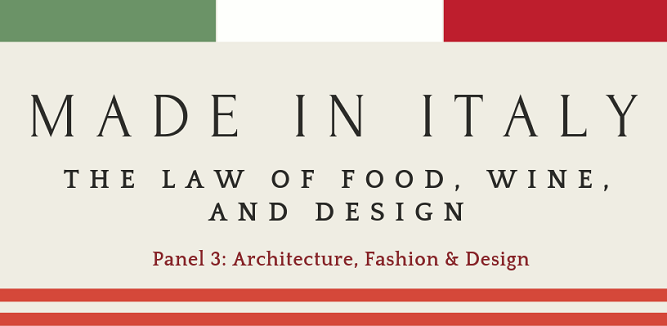
Event Title
Panel 3: Architecture, Fashion and Design
Location
Large Courtroom, FIU College of Law
Start Date
21-2-2020 2:00 PM
End Date
21-2-2020 3:45 PM
Description
Italian Style: on Law, Architecture and Design “Made in Italy”
Giovanni Marini, Università degli Studi di Perugia
Italian design, including interior design, urban design, fashion design and architectural design is recognized as being worldwide trendsetter. Italy today still exerts a vast influence worldwide. There were different trends in the 20s: a classical and a new one (“Rationalist”). After WWII, Italy had a true avant-guard moment. “When intellectuals lost their battle in 1948 and with it any chance to change land law and re-organize society, architects turned their attention to the object, the object conveyed meaning and showed direction.” In the 60s and 70s, Italian interior design reached its pinnacle (“Bel Design and Linea Italiana”). In MoMA New York, Emilio Ambasz organized an exhibit Italy, The New Domestic Landscape Achievements and Problems of Italian Design. In 1968, it developed an interesting trend (“radical design”) which opposed to the product design and mainstream “buon gusto.” The MoMA exhibit was also the end of Italian polycentric design, which focuses mainly on furniture (Italian) design. Modern interior design has changed the meaning of style and elegance, and many interior designers use Italian or Italian-inspired style in their work. The essay will analyze the birth and developments of the Italian style and its relationship to architectural trends in the globalization process, and with the ongoing transformation of capitalism and economic system.
Fashion Made in Italy: Tradition, Protection and a Look into a Sustainable Future
Barbara Pozzo, Università degli Studi dell’Insubria, Como
The essay focuses on fashion and will cover five distinct areas. First, the measures that the Italian government has launched in recent years to protect “traditional Italian brands.” Second, the various initiatives of certification and labeling in order to protect “made in Italy” fashion products. Third, the “made in Italy” label and the enormous problem of counterfeiting. Fourth, the use of Blockchain as a strategy for the protection of “made in Italy” products. Fifth, how sustainability is, or should become, a part of the “made in Italy” paradigm.
Culturally Identifiable Fashion: what role for GI’s?
Janewa Osei-Tutu, Florida International University College of Law
Geographical indications (GI’s) are a specialized form of intellectual property right. A GI is used when some quality, characteristic, or reputation of a good is attributable to its geographic origin. To the extent that geographic location and culture overlap, GI’s could be described as a form of cultural protection. Italy, which is known for both its food and fashion, has GI’s for a range of items, such as extra virgin olive oils, pastas, and wines. But, what is the role of GI’s when it comes to other aspects of culture, such as fashion? For example, the famous Italian designer, Valentino, received both praise and criticism for footwear modeled on royal sandals from Ghana. To what extent can GI’s be used as a form of cultural protection that extends beyond food and wines to protect culturally identifiable fashion items?
Panel 3: Architecture, Fashion and Design
Large Courtroom, FIU College of Law
Italian Style: on Law, Architecture and Design “Made in Italy”
Giovanni Marini, Università degli Studi di Perugia
Italian design, including interior design, urban design, fashion design and architectural design is recognized as being worldwide trendsetter. Italy today still exerts a vast influence worldwide. There were different trends in the 20s: a classical and a new one (“Rationalist”). After WWII, Italy had a true avant-guard moment. “When intellectuals lost their battle in 1948 and with it any chance to change land law and re-organize society, architects turned their attention to the object, the object conveyed meaning and showed direction.” In the 60s and 70s, Italian interior design reached its pinnacle (“Bel Design and Linea Italiana”). In MoMA New York, Emilio Ambasz organized an exhibit Italy, The New Domestic Landscape Achievements and Problems of Italian Design. In 1968, it developed an interesting trend (“radical design”) which opposed to the product design and mainstream “buon gusto.” The MoMA exhibit was also the end of Italian polycentric design, which focuses mainly on furniture (Italian) design. Modern interior design has changed the meaning of style and elegance, and many interior designers use Italian or Italian-inspired style in their work. The essay will analyze the birth and developments of the Italian style and its relationship to architectural trends in the globalization process, and with the ongoing transformation of capitalism and economic system.
Fashion Made in Italy: Tradition, Protection and a Look into a Sustainable Future
Barbara Pozzo, Università degli Studi dell’Insubria, Como
The essay focuses on fashion and will cover five distinct areas. First, the measures that the Italian government has launched in recent years to protect “traditional Italian brands.” Second, the various initiatives of certification and labeling in order to protect “made in Italy” fashion products. Third, the “made in Italy” label and the enormous problem of counterfeiting. Fourth, the use of Blockchain as a strategy for the protection of “made in Italy” products. Fifth, how sustainability is, or should become, a part of the “made in Italy” paradigm.
Culturally Identifiable Fashion: what role for GI’s?
Janewa Osei-Tutu, Florida International University College of Law
Geographical indications (GI’s) are a specialized form of intellectual property right. A GI is used when some quality, characteristic, or reputation of a good is attributable to its geographic origin. To the extent that geographic location and culture overlap, GI’s could be described as a form of cultural protection. Italy, which is known for both its food and fashion, has GI’s for a range of items, such as extra virgin olive oils, pastas, and wines. But, what is the role of GI’s when it comes to other aspects of culture, such as fashion? For example, the famous Italian designer, Valentino, received both praise and criticism for footwear modeled on royal sandals from Ghana. To what extent can GI’s be used as a form of cultural protection that extends beyond food and wines to protect culturally identifiable fashion items?

